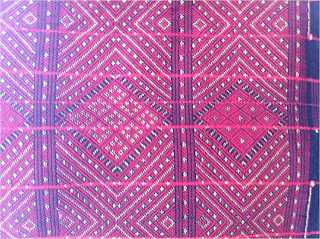This very finely woven Burmese (Chin) tribal vest is bought from a local antique dealer, Percy Veloo and it hangs on an antique loom stick.
 Different motifs represent the wearer’s status, signifying whether someone is married or what position they have in the village hierarchy. For example, a young woman dressed in traditional designs, signifies that she is open to being.
Different motifs represent the wearer’s status, signifying whether someone is married or what position they have in the village hierarchy. For example, a young woman dressed in traditional designs, signifies that she is open to being.
 The Chin is a Sino-Tibetan race, thought to have descended from central China. Within Burma, this little known people predominantly inhabit Chin State, which is located in the mountainous north-west of the country, bordering Bangladesh (to the west) and India (to the north). It is estimated that approximately half a million Chin live within Chin State, with an additional one million living inside Bangladesh and India. There is a concentration of Chin living on the Indo-Burman border, in a place known as Chinland.
The Chin is a Sino-Tibetan race, thought to have descended from central China. Within Burma, this little known people predominantly inhabit Chin State, which is located in the mountainous north-west of the country, bordering Bangladesh (to the west) and India (to the north). It is estimated that approximately half a million Chin live within Chin State, with an additional one million living inside Bangladesh and India. There is a concentration of Chin living on the Indo-Burman border, in a place known as Chinland.
 The Chin don't recognize the name Chin and prefer to be referred to after their individual tribes, which include the Asho, Cho, Khumi, Kuki, Laimi, Lushai and Zomi tribes. It is said that the name Chin is similar in pronunciation to the Burmese word for basket and that the Burmese used the name for the people because of the baskets they often carry. In contrast, it is written that Chin means companion in Burmese and the terms "Chin" and "Chindwin" are mentioned in the Pagan inscriptions from the beginning of the 13th century AD.
The Chin don't recognize the name Chin and prefer to be referred to after their individual tribes, which include the Asho, Cho, Khumi, Kuki, Laimi, Lushai and Zomi tribes. It is said that the name Chin is similar in pronunciation to the Burmese word for basket and that the Burmese used the name for the people because of the baskets they often carry. In contrast, it is written that Chin means companion in Burmese and the terms "Chin" and "Chindwin" are mentioned in the Pagan inscriptions from the beginning of the 13th century AD.
The Chin ethnic group consists of about 50 subgroups, and whilst each shares common customs, there is a degree of variation among them. Textiles passed down the family — memories of weddings and other important events — are considered treasured possessions but may be sold by families during difficult financial times.
 Different motifs represent the wearer’s status, signifying whether someone is married or what position they have in the village hierarchy. For example, a young woman dressed in traditional designs, signifies that she is open to being.
Different motifs represent the wearer’s status, signifying whether someone is married or what position they have in the village hierarchy. For example, a young woman dressed in traditional designs, signifies that she is open to being. The Chin is a Sino-Tibetan race, thought to have descended from central China. Within Burma, this little known people predominantly inhabit Chin State, which is located in the mountainous north-west of the country, bordering Bangladesh (to the west) and India (to the north). It is estimated that approximately half a million Chin live within Chin State, with an additional one million living inside Bangladesh and India. There is a concentration of Chin living on the Indo-Burman border, in a place known as Chinland.
The Chin is a Sino-Tibetan race, thought to have descended from central China. Within Burma, this little known people predominantly inhabit Chin State, which is located in the mountainous north-west of the country, bordering Bangladesh (to the west) and India (to the north). It is estimated that approximately half a million Chin live within Chin State, with an additional one million living inside Bangladesh and India. There is a concentration of Chin living on the Indo-Burman border, in a place known as Chinland. The Chin don't recognize the name Chin and prefer to be referred to after their individual tribes, which include the Asho, Cho, Khumi, Kuki, Laimi, Lushai and Zomi tribes. It is said that the name Chin is similar in pronunciation to the Burmese word for basket and that the Burmese used the name for the people because of the baskets they often carry. In contrast, it is written that Chin means companion in Burmese and the terms "Chin" and "Chindwin" are mentioned in the Pagan inscriptions from the beginning of the 13th century AD.
The Chin don't recognize the name Chin and prefer to be referred to after their individual tribes, which include the Asho, Cho, Khumi, Kuki, Laimi, Lushai and Zomi tribes. It is said that the name Chin is similar in pronunciation to the Burmese word for basket and that the Burmese used the name for the people because of the baskets they often carry. In contrast, it is written that Chin means companion in Burmese and the terms "Chin" and "Chindwin" are mentioned in the Pagan inscriptions from the beginning of the 13th century AD.
No comments:
Post a Comment